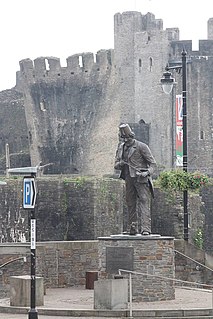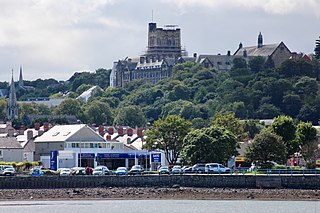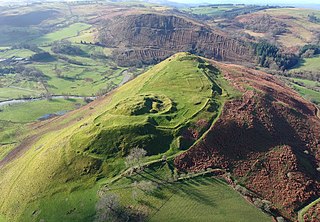Related Research Articles

Manorialism, also known as the manor system or manorial system, was the method of land ownership in parts of Europe, notably England, during the Middle Ages. Its defining features included a large, sometimes fortified manor house in which the lord of the manor and his dependents lived and administered a rural estate, and a population of labourers who worked the surrounding land to support themselves and the lord. These labourers fulfilled their obligations with labour time or in-kind produce at first, and later by cash payment as commercial activity increased. Manorialism is sometimes included as part of the feudal system.

Glamorgan, or sometimes Glamorganshire, is one of the thirteen historic counties of Wales and a former administrative county of Wales. Originally an early medieval petty kingdom of varying boundaries known as Glywysing, then taken over by the Normans as a lordship, the area that became known as Glamorgan was both a rural, pastoral area, and a conflict point between the Norman lords and the Welsh princes. It was defined by a large concentration of castles.

The open-field system was the prevalent agricultural system in much of Europe during the Middle Ages and lasted into the 20th century in Russia, Iran, and Turkey. Under the open-field system, each manor or village had two or three large fields, usually several hundred acres each, which were divided into many narrow strips of land. The strips or selions were cultivated by individuals or peasant families, often called tenants or serfs. The holdings of a manor also included woodland and pasture areas for common usage and fields belonging to the lord of the manor and the religious authorities, usually Roman Catholics in medieval Western Europe. The farmers customarily lived in individual houses in a nucleated village with a much larger manor house and church nearby. The open-field system necessitated co-operation among the inhabitants of the manor.

Deheubarth was a regional name for the realms of south Wales, particularly as opposed to Gwynedd. It is now used as a shorthand for the various realms united under the House of Dinefwr, but that Deheubarth itself was not considered a proper kingdom on the model of Gwynedd, Powys, or Dyfed is shown by its rendering in Latin as dextralis pars or as Britonnes dexterales and not as a named land. In the oldest British writers, Deheubarth was used for all of modern Wales to distinguish it from Hen Ogledd, the northern lands whence Cunedda and the Cymry originated.

Trellech is a village and parish in Monmouthshire, south-east Wales. Located 5 miles (8 km) south of Monmouth and 4 miles (6.4 km) north-north-west of Tintern, Trellech lies on a plateau above the Wye Valley on the southern fringes of 320 acres (130 ha) of woodland in an Area of Outstanding Natural Beauty. Three Bronze Age standing stones are situated in the village, known as Harold's Stones, which overlook the historic church of St Nicholas, a Grade I listed building.

Caerphilly is a town and community in Wales. It is situated at the southern end of the Rhymney Valley.

Carmarthen is the county town of Carmarthenshire and a community in Wales, lying on the River Towy. 8 miles (13 km) north of its estuary in Carmarthen Bay. The population was 14,185 in 2011, down from 15,854 in 2001, but gauged at 16,285 in 2019. It has a claim to be the oldest town in Wales – Old Carmarthen and New Carmarthen became one borough in 1546. It was the most populous borough in Wales in the 16th–18th centuries, described by William Camden as "chief citie of the country". Growth stagnated by the mid-19th century as new settlements developed in the South Wales Coalfield.

Bangor is a cathedral city and community in Gwynedd, North Wales. It is the oldest city in Wales. Historically part of Caernarfonshire, it had a population of 18,322 at the 2019 UK Office for National Statistics. The city is best know for local landmarks such as Menai Suspension Bridge connecting the city and Isle of Anglesey, Bangor Cathedral, Bangor University and Garth Pier.

Colwinston is both a village and a community in the Vale of Glamorgan, Wales, approximately 4 miles (6.4 km) southeast of the centre of Bridgend and 21 miles (34 km) west of the centre of Cardiff. The village is located within 1⁄2 mile (0.80 km) of the A48. The population in 2005 was approximately 400 but with recent building development, the population is now estimated at over 600 people.

Cyfraith Hywel, also known as Welsh law, was the system of law practised in medieval Wales before its final conquest by England. Subsequently, the Welsh law's criminal codes were superseded by the Statute of Rhuddlan in AD 1284 and its civil codes by Henry VIII's series of Laws in Wales Acts between 1535 and 1542.

Cefnllys Castle was a medieval spur castle in Radnorshire, Wales. Two successive masonry castles were built on a ridge above the River Ithon known as Castle Bank in the thirteenth century, replacing a wooden motte-and-bailey castle constructed by the Normans nearby. Controlling several communication routes into the highlands of Mid Wales, the castles were strategically important within the Welsh Marches during the High Middle Ages. As the seat of the fiercely contested lordship and cantref of Maelienydd, Cefnllys became a source of friction between Llywelyn ap Gruffudd and Roger Mortimer in the prelude to Edward I's conquest of Wales (1277–1283). Cefnllys was also the site of a borough and medieval town.

Vaynol or Y Faenol is a country estate dating from the Tudor period near Y Felinheli in Gwynedd, North Wales. It has 1,000 acres (4.0 km2) of park, farmland, and gardens, with more than thirty listed buildings, surrounded by a wall which is 7 miles (11 km) long. "Y Faenol" means "the manor" and is a mutated form of the Welsh word maenol.

Saundersfoot is a large village, community and electoral ward in Pembrokeshire, Wales. It is near Tenby, both being holiday destinations. Saundersfoot lies in the Pembrokeshire Coast National Park and on the Pembrokeshire Coast Path. The village population was 3,361 in 2011.

Llanblethian is a village in the Vale of Glamorgan in Wales which sits upon the River Thaw. It makes up part of the community of Cowbridge with Llanblethian, which consists of the village itself, the larger market town of Cowbridge and Aberthin.

There are holidays traditionally celebrated in Wales that are not shared with the rest of the United Kingdom. Excluding those that fall at the same time as UK-wide public holidays, none of these traditional holidays are bank holidays. There is, however, much support for the recognition of St David's Day as a bank holiday in Wales, in the same way as St Patrick's Day in Northern Ireland, and St Andrew's Day in Scotland.

Castlemorris is a small village in the parish and community of Mathry, Pembrokeshire, Wales, south of the Western Cleddau river, on the B4331 road between Mathry and Letterston. It has a population of roughly 150 people.

Penrhys is a village in the county borough of Rhondda Cynon Taf, Wales, situated on a hillside overlooking both valleys of Rhondda Fawr and Rhondda Fach. It is situated around 1,100 ft above sea level and is a district of Tylorstown. Until the late 16th century, Penrhys was one of the holiest sites for Christian pilgrims in Wales.

Wrinstone or Wrinston is a medieval hamlet, just east of Wenvoe, Vale of Glamorgan, south Wales. The Wrinstone estate was variously also known as Wrenston, Wrencheston or Wrenchester. The Barry Railway line ran past the hamlet and entered the Wenvoe Tunnel just to the north near Wenvoe Quarry. It closed after a fire in 1963.
Welsh units of measurement are those in use in Wales between the Sub-Roman period and the 13th-century Edwardian conquest. Modern Wales no longer employs these units even for customary purposes but instead follows the custom as elsewhere in Britain of using a mixture of metric and Imperial units.
A taeog was a native serf or villein of the medieval Welsh kingdoms. The term was used in south Wales and literally denoted someone "belonging to the house" (ty) of the lord's manor. The equivalent term in north Wales was aillt or mab aillt.
References
- ↑ Jones, R.A. (1998). "Problems with medieval Welsh local administration—the case of the maenor and the maenol". Journal of Historical Geography . 24 (2): 135–146. doi:10.1006/jhge.1998.0082.
- 1 2 3 Wade-Evans, Arthur. Welsh Medieval Law . Oxford Univ., 1909. Accessed 1 Feb 2013.
- ↑ Wade-Evans. p. 348.
- ↑ Wade-Evans. p. 349.